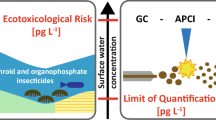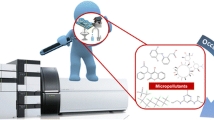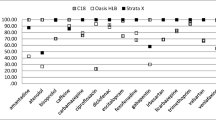Abstract
A comprehensive method for the analysis of 11 target pharmaceuticals representing multiple commonly used therapeutic classes was developed for biological tissues (fish), reclaimed water, and the surface water directly affected by irrigation with reclaimed water. One gram of fish tissue homogenate was extracted by accelerated solvent extraction with methylene chloride followed by mixed-mode cation exchange solid phase extraction (SPE) cleanup and analyzed by liquid chromatography-tandem mass spectrometry. Compared to previously reported methods, the protocol produces cleaner extracts resulting in lower method detection limits. Similarly, an SPE method based on Oasis HLB cartridges was used to concentrate and cleanup reclaimed and surface water samples. Among the 11 target compounds analyzed, trimethoprim, caffeine, sulfamethoxazole, diphenhydramine, diltiazem, carbamazepine, erythromycin, and fluoxetine were consistently detected in reclaimed water. Caffeine, diphenhydramine, and carbamazepine were consistently detected in fish and surface water samples. Bioaccumulation factors for caffeine, diphenhydramine, and carbamazepine in mosquito fish (Gambusia holbrooki) were calculated at 29 ± 26, 821 ± 422, and 108 ± 144, respectively. This is the first report of potential accumulation of caffeine in fish from a water body directly influenced by reclaimed water.

The pharmaceuticals detected in reclaimed water and the fresh water directly affected by reclaimed water.



Similar content being viewed by others
References
Daughton CG, Ternes TA (1999) Pharmaceuticals and personal care products in the environment: agents of subtle change? Environ Health Perspect 107(Suppl 6):907–938
Boyd GR, Reemtsma H, Grimm DA, Mitra S (2003) Pharmaceuticals and personal care products (PPCPs) in surface and treated waters of Louisiana, USA and Ontario, Canada. Sci Total Environ 311(1–3):135–149
Heberer T (2002) Occurrence, fate, and removal of pharmaceutical residues in the aquatic environment: a review of recent research data. Toxicol Lett 131(1–2):5–17
Ramirez AJ, Brain RA, Usenko S, Mottaleb MA, O’Donnell JG, Stahl LL, Wathen JB, Snyder BD, Pitt JL, Perez-Hurtado P, Dobbins LL, Brooks BW, Chambliss CK (2009) Occurrence of pharmaceuticals and personal care products (PPCPs) in fish: results of a national pilot study in the U.S. Environ Toxicol Chem 28(12):2587–2597
Ramirez AJ, Mottaleb MA, Brooks BW, Chambliss CK (2007) Analysis of pharmaceuticals in fish using liquid chromatography-tandem mass spectrometry. Anal Chem 79(8):3155–3163
Expanded Investigations of Pharmaceuticals in Fish Tissue (2009) US Environmental Protection Agency http://waterepagov/scitech/swguidance/ppcp/fish-expandcfm (Accessed 1 Oct 2010)
Brooks BW, Chambliss CK, Stanley JK, Ramirez A, Banks KE, Johnson RD, Lewis RJ (2005) Determination of select antidepressants in fish from an effluent-dominated stream. Environ Toxicol Chem 24(2):464–469
Tang HP, Ho C, Lai SS (2006) High-throughput screening for multi-class veterinary drug residues in animal muscle using liquid chromatography/tandem mass spectrometry with on-line solid-phase extraction. Rapid Commun Mass Spectrom 20(17):2565–2572
Chu S, Metcalfe CD (2007) Analysis of paroxetine, fluoxetine and norfluoxetine in fish tissues using pressurized liquid extraction, mixed mode solid phase extraction cleanup and liquid chromatography-tandem mass spectrometry. J Chromatogr A 1163(1–2):112–118
Berrada H, Borrull F, Font G, Marce RM (2008) Determination of macrolide antibiotics in meat and fish using pressurized liquid extraction and liquid chromatography-mass spectrometry. J Chromatogr A 1208(1–2):83–89
Nakamura Y, Yamamoto H, Sekizawa J, Kondo T, Hirai N, Tatarazako N (2008) The effects of pH on fluoxetine in Japanese medaka (Oryzias latipes): acute toxicity in fish larvae and bioaccumulation in juvenile fish. Chemosphere 70(5):865–873
Zhou SN, Oakes KD, Servos MR, Pawliszyn J (2008) Application of solid-phase microextraction for in vivo laboratory and field sampling of pharmaceuticals in fish. Environ Sci Technol 42(16):6073–6079
Smith S, Gieseker C, Reimschuessel R, Decker CS, Carson MC (2009) Simultaneous screening and confirmation of multiple classes of drug residues in fish by liquid chromatography-ion trap mass spectrometry. J Chromatogr A 1216(46):8224–8232
Lajeunesse A, Gagnon C, Sauve S (2008) Determination of basic antidepressants and their N-desmethyl metabolites in raw sewage and wastewater using solid-phase extraction and liquid chromatography-tandem mass spectrometry. Anal Chem 80(14):5325–5333
Pedro A, Segura CG, Sauve S (2007) Afully automated on-line preconcentration and liquid chromatography-tandem mass spectrometry method for the analysis of anti-infectives in wastewaters. Analytical Chimica Acta 604:147–157
Pedro A, Segura CG, Sauve S (2009) Application of turbulent flow chromatography load columns for the on-line analysis of anti-infectives in wastewaters. Chromatographia 70:239–245
Tavazzi S, Benfenati E, Barcelo D (2002) Accelerated solvent extraction then liquid chromatography coupled with mass spectrometry for determination of 4-t-octylphenol, 4-nonylphenols, and bisphenol A in fish liver. Chromatographia 56:463–467
Balmer ME, Poiger T, Droz C, Romanin K, Bergqvist PA, Muller MD, Buser HR (2004) Occurrence of methyl triclosan, a transformation product of the bactericide triclosan, in fish from various lakes in Switzerland. Environ Sci Technol 38(2):390–395
Buser HR, Balmer ME, Schmid P, Kohler M (2006) Occurrence of UV filters 4-methylbenzylidene camphor and octocrylene in fish from various Swiss rivers with inputs from wastewater treatment plants. Environ Sci Technol 40(5):1427–1431
Duedahl-Olesen L, Cederberg T, Pedersen KH, Hojgard A (2005) Synthetic musk fragrances in trout from Danish fish farms and human milk. Chemosphere 61(3):422–431
Mottaleb MA, Usenko S, O’Donnell JG, Ramirez AJ, Brooks BW, Chambliss CK (2009) Gas chromatography-mass spectrometry screening methods for select UV filters, synthetic musks, alkylphenols, an antimicrobial agent, and an insect repellent in fish. J Chromatogr A 1216(5):815–823
Rudel H, Bohmer W, Schroter-Kermani C (2006) Retrospective monitoring of synthetic musk compounds in aquatic biota from German rivers and coastal areas. J Environ Monit 8(8):812–823
Datta S, Loyo-Rosales JE, Rice CP (2002) A simple method for the determination of trace levels of alkylphenolic compounds in fish tissue using pressurized fluid extraction, solid phase cleanup, and high-performance liquid chromatography fluorescence detection. J Agric Food Chem 50(6):1350–1354
Draisci R, Marchiafava C, Ferretti E, Palleschi L, Catellani G, Anastasio A (1998) Evaluation of musk contamination of freshwater fish in Italy by accelerated solvent extraction and gas chromatography with mass spectrometric detection. J Chromatogr A 814(1–2):187–197
Haglund P, Sporring S, Wiberg K, Bjorklund E (2007) Shape-selective extraction of PCBs and dioxins from fish and fish oil using in-cell carbon fractionation pressurized liquid extraction. Anal Chem 79(7):2945–2951
Llorca M, Farre M, Pico Y, Barcelo D (2009) Development and validation of a pressurized liquid extraction liquid chromatography-tandem mass spectrometry method for perfluorinated compounds determination in fish. J Chromatogr A 1216(43):7195–7204
Losada S, Santos FJ, Galceran MT (2009) Selective pressurized liquid extraction of polybrominated diphenyl ethers in fish. Talanta 80(2):839–845
Lund M, Duedahl-Olesen L, Christensen JH (2009) Extraction of polycyclic aromatic hydrocarbons from smoked fish using pressurized liquid extraction with integrated fat removal. Talanta 79(1):10–15
Wahlen R (2004) Fast and accurate determination of arsenobetaine in fish tissues using accelerated solvent extraction and HPLC-ICP-MS determination. J Chromatogr Sci 42(4):217–222
Segura PA, Gagnon C, Sauve S (2007) A fully automated on-line preconcentration and liquid chromatography-tandem mass spectrometry method for the analysis of anti-infectives in wastewaters. Anal Chim Acta 604(2):147–157
Vanderford BJ, Pearson RA, Rexing DJ, Snyder SA (2003) Analysis of endocrine disruptors, pharmaceuticals, and personal care products in water using liquid chromatography/tandem mass spectrometry. Anal Chem 75(22):6265–6274
Renew JE, Huang CH (2004) Simultaneous determination of fluoroquinolone, sulfonamide, and trimethoprim antibiotics in wastewater using tandem solid phase extraction and liquid chromatography-electrospray mass spectrometry. J Chromatogr A 1042(1–2):113–121
EPA pilot study of PPCPs in fish tissue. http://www.epa.gov/waterscience/ppcp/files/fish-pilot.pdf (accessed November 2009)
Wang C (2012) Assessment of the occurrence and potential effects of pharmaceuticals and personal care products in south Florida water and sediment. PhD dissertation. Florida International University, FL, p 173
Hirsch R, Ternes T, Haberer K, Kratz KL (1999) Occurrence of antibiotics in the aquatic environment. Sci Total Environ 225(1–2):109–118
Commission Decision (2002/657/EC) of 12 August 2002 Implementing Council Directive 96/23/EC concerning the performance of analytical methods and the interpretation of results. Official Journal of the European Communities L221:8–3
Qiang Z, Adams C (2004) Potentiometric determination of acid dissociation constants (pKa) for human and veterinary antibiotics. Water Res 38(12):2874–2890
Nelis HJCF, De Leenheer AP (1983) Isocratic nonaqueous reversed-phase liquid chromatography of carotenoids. Anal Chem 55(2):270–275
Definition and procedure for the determination of the method detection limit (1986). Code of Federal Regulations Title 40: Section 136, Appendix B
Kwon JW, Armbrust KL (2006) Laboratory persistence and fate of fluoxetine in aquatic environments. Environ Toxicol Chem 25(10):2561–2568
Andrisano V, Hrelia P, Gotti R, Leoni A, Cavrini V (2001) Photostability and phototoxicity studies on diltiazem. J Pharm Biomed Anal 25(3–4):589–597
Kwon JW, Armbrust KL (2005) Degradation of citalopram by simulated sunlight. Environ Toxicol Chem 24(7):1618–1623
Davis JG, Truman CC, Kim SC, Ascough JC 2nd, Carlson K (2006) Antibiotic Transport via Runoff and Soil Loss. J Environ Qual 35(6):2250–2260
Vernouillet G, Eullaffroy P, Lajeunesse A, Blaise C, Gagne F, Juneau P (2010) Toxic effects and bioaccumulation of carbamazepine evaluated by biomarkers measured in organisms of different trophic levels. Chemosphere 80(9):1062–1068
Duffy EM, Jorgensen WL (2000) Prediction of properties from simulations: free energies of solvation in hexadecane, octanol, and water. J Am Chem Soc 122:2878–2888
KABAM Version 1.0 (Kow (based) Aquatic BioAccumulation Model) www.epa.gov/oppefed1/models/water/kabam/kabam_v1_0.xls (Accessed 5 March 2012)
Gossett R, Brown D, Young D (1983) Predicting the bioaccumulation of organic compounds in marine organisms using octanol/water partition coefficients. Mar Pollut Bull 14(10):387–392
Acknowledgments
Authors would like to thank Thermo Scientific for providing analytical supports and the Miami Dade County-Biscayne Bay Coastal Wetlands Rehydration Pilot project for partial financial support. This is Southeast Environmental Research Center contribution 558.
Author information
Authors and Affiliations
Corresponding author
Additional information
Published in the topical collection Emerging Contaminants in Biota with guest editors Yolanda Picó and Damià Barceló.
Rights and permissions
About this article
Cite this article
Wang, J., Gardinali, P.R. Analysis of selected pharmaceuticals in fish and the fresh water bodies directly affected by reclaimed water using liquid chromatography-tandem mass spectrometry. Anal Bioanal Chem 404, 2711–2720 (2012). https://doi.org/10.1007/s00216-012-6139-8
Received:
Revised:
Accepted:
Published:
Issue Date:
DOI: https://doi.org/10.1007/s00216-012-6139-8




